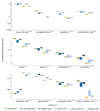Simultaneous Quantification of Organic Acids in Tamarillo (Solanum betaceum) and Untargeted Chemotyping Using Methyl Chloroformate Derivatisation and GC-MS
- PMID: 35209098
- PMCID: PMC8875926
- DOI: 10.3390/molecules27041314
Simultaneous Quantification of Organic Acids in Tamarillo (Solanum betaceum) and Untargeted Chemotyping Using Methyl Chloroformate Derivatisation and GC-MS
Abstract
Sixteen organic acids were quantified in peel and pulp of Amber, Laird's Large and Mulligan cultivars of tamarillo using GC-MS. Fourteen of these compounds had not previously been quantified in tamarillo. An untargeted metabolomics approach was used in parallel to identify and quantify 64 more metabolites relative to the internal standard, indicating abundances of glutamic acid, pro-line, aspartic acid and γ-aminobutyric acid as well as lower concentrations of several other essential fatty acids and amino acids. The main findings were that total organic acid concentration was significantly higher (p < 0.05) in pulp than in peel, with the highest concentration seen in Mulligan pulp (219.7 mg/g DW). Remarkably, after citric acid, the potent bactericide itaconic acid was the second most abundant organic acid. At least 95% of organic acids in tamarillo were one of these two acids, as well as cis-aconitic, malic and 4-toluic acids. Differences between cultivar chemotypes were as substantial as differences between tissues. These results suggest that the bitter flavour of the peel does not result from organic acids. The combination of targeted and untargeted metabolomics techniques for simultaneous qualitative and quantitative investigation of nutrients and flavours is efficient and informative.
Keywords: citric acid; fruit; itaconic acid; metabolite profiling; metabolomics; ripening.
Conflict of interest statement
The authors declare no conflict of interest.
Figures





References
-
- Lister C.E., Morrison S.C., Kerkhofs N.S., Wright K.M. The nutritional composition and health benefits of New Zealand tamarillos. Crop Food Res. Confid. Rep. 2005;1281:29.
-
- Diep T.T., Pook C., Yoo M.J.Y. Physicochemical properties and proximate composition of tamarillo (Solanum betaceum Cav.) fruits from New Zealand. J. Food Compos. 2020;92:103563. doi: 10.1016/j.jfca.2020.103563. - DOI
MeSH terms
Substances
LinkOut - more resources
Full Text Sources
Miscellaneous

